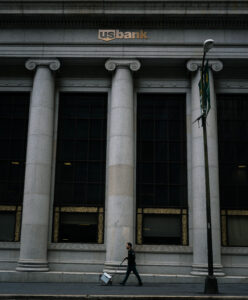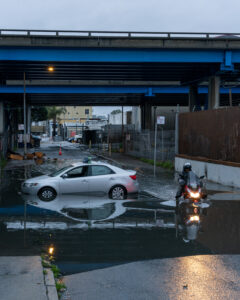When the COVID pandemic in 2020 encouraged working from home, various companies embraced this style of working. The San Francisco Downtown area, once a hub for these companies is now experiencing a permanent loss in workers. As a result, the local economy will face a big deficit.
San Francisco is projecting a deficit of hundreds of millions of dollars in lost property taxes, business taxes and real estate transfer taxes. Meanwhile, SF’s elected officials and community organizations are diligently working to imagine a way out and rebuild the city economy. If the deficit is not sufficiently addressed, it will harm many departments and organizations that rely on funding from the City.
In the aftermath of the 2008 Recession, San Francisco began heavily relying on the technology industry to build up its economy. Elected officials supercharged the tech boom by changing tax structures to favor startup growth in Downtown SF. Companies such as Twitter, Salesforce, Airbnb, Yelp and more moved into the area, along with their young and well-paid workers. Due to these successes, San Francisco began favoring and building its economy around these startups.
When the COVID pandemic hit in 2020, many tech companies pioneered remote work, embracing the public safety protocols. Twitter and Salesforce, the city’s largest private employers, no longer required workers in the office. Today, many of these workers have now moved out of the city or Bay Area altogether.
Chris Wright, Senior Vice President at business advocacy organization Advance SF said, “there was an entire workforce of 300,000 people that used to come to San Francisco and spend money all day long, inside the core of the [downtown] area — going to the theater, going to work, going to a game — and they’re not here now.”
The city’s heavy reliance on tech companies’ workers in Downtown has made the economy especially vulnerable to the lack of workers now, demonstrated through the projected budget deficit.

City economist Ted Egan explained that in 2021, office space industries contributed to about 79% of the Growth Domestic Product, or in other words, economic value. Because of the vacant office spaces and lessened foot traffic, which is currently at only 36% of its pre-pandemic levels, there is projected to be $125 million lost in SF property taxes by 2028.
On December 15, 2022, Mayor London Breed’s office announced that the city budget is projecting a shortfall of more than $200 million in the 2024 fiscal year and a $528 million deficit in the 2025 fiscal year. Breed’s office predicted that by the 2028 fiscal year, this shortfall could reach $1.2 billion.
Economists believe that the city needs to create more opportunities for the office market to thrive again. Egan said that in order to recover the economy, “we need the office market to adjust.”
Mayor Breed recently addressed this issue by creating more opportunities for office buildings to fill up. Her recent roadmap for Downtown’s recovery in the State of the City Address on February 9th, 2023, included an opportunity to fill office space, which is currently 27% vacant, by inviting companies with a $1 million annual discount on their gross receipts taxes for up to three years.

photo by Odin Marin
“We need to be treating workers like we treat visitors and tourists,” Wright said. To do so, various organizations are revitalizing the area to attract more people back to Downtown. The Downtown SF Partnership is a nonprofit community benefit district that created the Public Realm Action Plan in July 2022 working on various solutions to invite more people back into the area. To do so, they have closed streets to car traffic, held frequent outdoor events, and made the area more attractive in general. “The plan is a perfect example of how to activate a space,” Wright said.
Elected city officials also believe in using Downtown for not only just a place to work, but a place where people can live and spend time leisurely. San Francisco District Supervisors have been working on how to grow the area’s residential base in the area as a way of increasing sustainable economic activity.
However, there are many policy impediments, and any form of economic redevelopment will require a shift in city and land-use policies and regulations. On February 7th, 2023, District 11 Supervisor Ahsha Safai called a legislative hearing on using downtown buildings for residential purposes, which will take place in March.
Lauren Chung, legislative aide to Supervisor Safai stated that the hearing would “highlight the steps we need to take to make the process of turning office buildings to residential spaces more attractive.” Chung said that converting the buildings would be just “one piece of the recovery.”
Community members also believe improving the current transit services and bringing more services to Downtown will revitalize the area. Hayden Miller, a member of the San Francisco Municipal Transportation Agency (SFMTA) Youth Transportation Advisory Board (YTAB), said, “Public transit has suffered greatly during the pandemic with a long way to go to reach full ridership and revenue recovery. The most important thing right now is for state and federal leaders to understand the critical role public transit plays in creating accessible and vibrant downtowns and provide funding to sustain and expand service accordingly.”
“Public transit has the ability to carry large numbers of people to downtown without the stress of traffic or parking. For example, BARTs transbay tube can carry more people per hour into the city than the 10 lane Bay Bridge,” Miller said.
The SFMTA is diligently working to restore Downtown transit services. The 1X California Express route is returning on February 21, 2023 which will cut down several minutes in the commute from the Outer Richmond to Downtown, and also relieve overcrowding on the 1 Local route.
Danny Sauter, Executive Director of San Francisco Neighborhood Centers, said that “some of these processes to revive Downtown are going to take years, but that shouldn’t be an excuse to not do anything now.”
In addition to figuring out how to get Downtown back on its feet, San Francisco elected officials will have to figure out how to maintain and fund city programs with this overwhelming upcoming deficit.
Sally Ma, Deputy Budget Director in the Mayor’s Office of Public Policy and Finance stated that the Mayor’s office will be working with each department to help meet their needs. Ma said that departments will likely face 5-8% cuts.
Vice Chair of the San Francisco Youth Commission Ewan Barker Plummer said, that the “The Department of Children, Youth, and Families’s budget could be cut, and there are concerns for the budget for Free Muni for all Youth. Another big concern is the creation of debt that future generations of San Franciscans will have to pay off,” they said.
Barker Plummer also predicted that the 2022 Prop G, Student Success Fund, which was meant to provide grants to San Francisco Unified School District (SFUSD) schools, could also be cut. Barker Plummer said, “There’s so little money in that pot that the promise for community program funding for schools is gone, which will have a major impact on the SFUSD community.”
Alondra Esquivel Garcia, Vice President of the San Francisco Women’s Political Committee said, “I’m nervous that key resources and programs will be cut due to the deficit the city is facing. If key services like youth after school programming or harm reduction resources get cut, how will the city continue to make progress? We have to keep investing and maximizing what we currently have.”
After announcing the budget deficit on December 15, 2022, Breed issued budget instructions to department heads to guide the budget process for Fiscal Years 2023-24 and 2024-25. She instructed departments to continue hiring for jobs that address her core priorities, which include public safety, homelessness, street cleanliness, mental health and economic recovery. Additionally, she directed department heads to prioritize filling vacant positions for core City services that will support the city’s economic recovery.
City departments are required to submit their proposed budgets by late February through the City Controller’s Office. After the budget proposals, the Mayor’s Budget Office will evaluate the requests and develop the Mayor’s proposed balanced budget which will be submitted to the Board of Supervisors by June. Then, the Supervisors will consider the budget and send a balanced budget back to the Mayor for signature by August.







CLAIM SPACE ID AIRDROP 2023 | EARN MORE THAN 1.007ETH | LAST CHANCE https://www.tiktok.com/@bigggmoneys/video/7216825799645678854
CLAIM SPACE ID AIRDROP 2023 | EARN MORE THAN 1.007ETH | LAST CHANCE https://t.co/5I6J1BLRko
Blur CRYPTO Airdrop 2023 | NEW CRYPTO AIRDROP GUIDE 2023 | CLAIM NOW $2500 https://cos.tv/videos/play/43670739785125888
I was very pleased to uncover this great site. I need to to thank you for ones time for this fantastic read!! I definitely appreciated every bit of it and I have you bookmarked to look at new information on your blog.
Your bonus from http://gg.gg/13oh3t connect your wallet and enter promo code (3gSwd234) and get 0.5 eth + 300 free spins, Withdrawal without
ZkSync Free Airdrop Crypto: Your Guide to Free Coins in 2023, EARN MORE THAN $1000! https://youtu.be/o1JvjQA-s-M
Code Promo 1xBet https://www.planeterenault.com/UserFiles/files/?code_promo_69.html